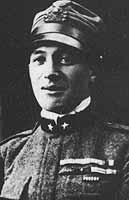
Count Francesco Baracca was Italy's top fighter ace of World War I. He was credited with 34 aerial victories. The emblem he wore side by side on his plane of a black horse prancing on its two rear hooves inspired Enzo Ferrari to use it on his racing car and later in his automotive company.

Fulco VIII, Prince Ruffo di Calabria, 6th Duke of Guardia Lombarda was an Italian World War I flying ace and senator of the Kingdom from 1934 until his death. He was the father of Paola, Queen of the Belgians.

The Italian Corpo Aeronautico Militare was formed as part of the Regio Esercito on 7 January 1915, incorporating the Aviators Flights Battalion (airplanes), the Specialists Battalion (airships) and the Ballonists Battalion. Prior to World War I, Italy had pioneered military aviation in the Italo-Turkish War during 1911–1912. Its army also contained one of the world's foremost theorists about the future of military aviation, Giulio Douhet; Douhet also had a practical side, as he was largely responsible for the development of Italy's Caproni bombers starting in 1913. Italy also had the advantage of a delayed entry into World War I, not starting the fight until 24 May 1915, but took no advantage of it so far as aviation was concerned.

Flavio Torello Baracchini was an Italian World War I fighter ace credited with 21 confirmed and nine unconfirmed aerial victories. His confirmed victory total ranked him fourth among Italian aces of the war.
Sottotenente Michele Allasia was a World War I fighter ace credited with five aerial victories.
Tenente Giovanni Sabelli was an Italian World War I flying ace credited with five aerial victories. At the start of World War I, he was already an experienced combat pilot.
Tenente Luigi Olivi (1894–1917) was an Italian World War I flying ace credited with six aerial victories. He won two awards of the Silver Medal for Military Valor and was killed in action.
Antonio Riva was an Italian pilot and a World War I flying ace, credited with seven confirmed and seven unconfirmed aerial victories. In 1951, he was executed by firing squad under the newly established People's Republic of China for allegedly conspiring to assassinate Mao Zedong and other Communist leaders.
TenenteLuigi Olivari was a World War I flying ace who claimed 19 aerial victories. His Spad VII stalled into a fatal crash on 13 October 1917. Posthumously, he was awarded credit for eight aerial victories.
Tenente Gastone Novelli was a World War I flying ace credited with eight aerial victories.
TenenteCarlo Francesco Lombardi known as Francis was a World War I flying ace credited with eight aerial victories. Postwar, he was active in his family's rice refinery, as well as in record breaking flights. He formed the AVIA aviation company in 1938.

Tenente colonnelloAlvaro Leonardi was a World War I Sottotenente from Italy and a flying ace credited with eight aerial victories.
Capitano Antonio Reali was an Italian World War I flying ace credited with eleven confirmed aerial victories, and 22 unconfirmed victories. He served in the Regia Aeronautica Reserves from 1923 to about 1940.

LieutenantGiovanni 'Giannino' Ancillotto was an Italian World War I flying ace credited with 11 confirmed aerial victories. Rather unusually, he served solely with aviation while he was in the military, beginning in the lowest rank. Among his aerial victories as a fighter pilot were three over enemy observation balloons right after the Battle of Caporetto. As an example of the hazards of balloon busting, on 5 December 1917 Ancillotto returned to base with singed swatches of the third balloon's fabric adhering to his damaged fighter plane.

76a Squadriglia of the Corpo Aeronautico Militare was one of Italy's original fighter squadrons, being founded during World War I on 25 May 1916. On 30 May 1916, the new unit began its combat career. Between 22 April and 3 October 1917, three of its commanding officers became casualties. It was drawn into the air fighting over Caporetto in late 1917, and forced to retreat three times during November as a consequence of the Italian defeat.
77a Squadriglia was one of the first Italian fighter squadrons. After its founding on 31 May 1916, it began flying combat in July 1916, and would operate until the end of World War I. It was one of the squadrons drawn into late 1917's Battle of Caporetto, and forced to retreat after the Italian defeat. By the time the Austro-Hungarians sued for peace, 77a Squadriglia could count some 50 aerial victories scored in about 250 victories.

78a Squadriglia was one of the original Italian fighter squadrons of World War I, serving in combat from 29 June 1916 to 3 November 1918. They flew 4,770 combat missions and were credited with 88 aerial victories.
79a Squadriglia was one of Italy's first fighter squadrons. It served in combat during World War I from 13 January 1917 though war's end. It was credited with 47 aerial victories.

80a Squadriglia was an Italian fighter squadron founded in 1917 to serve in support of the Battles of the Isonzo in northern Italy. By war's end, it had been credited with 21 aerial victories without suffering any of its own personnel casualties.

81a Squadriglia was an Italian fighter squadron raised in March 1917 that served through the end of World War I. One of its aces, Flavio Baracchini, would become the first awardee of the Gold Medal for Military Valor. The squadron would be credited with 34 aerial victories, and suffer four dead. It ended the war with 28 aircraft on strength.










